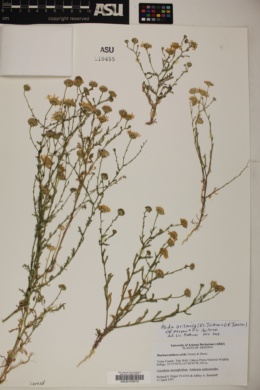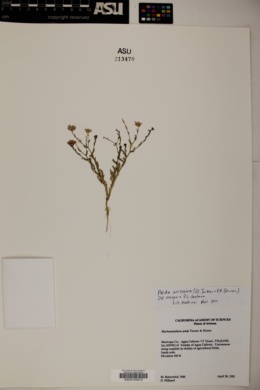Arida arizonica
|
|
|
|
Family: Asteraceae
arid tansyaster, more...arid machaeranthera
[Machaeranthera ammophila Reveal, moreMachaeranthera amophila Reveal, Machaeranthera arida B.L. Turner & Horne, Machaeranthera arizonica Jackson & Johnston, Machaeranthera coulteri var. arida (B.L. Turner & Horne) B.L. Turner] |
Annuals, 5-40 cm; taproots slender. Stems usually 1, sometimes 2-6+, erect to ascending, slender, usually much branched from base, divaricately so, densely hispiduloso-glandular, viscid. Leaves basal and cauline; proximal petiolate, distal sessile, often clasping; blades oblanceolate to oblong, reduced distally, 10-50(-70) × 1-25 mm, herbaceous, margins coarsely dentate or pinnatifid, apices of teeth or lobes spiny-tipped, faces glandular-hispidulous. Heads borne singly (terminal),often in loose, leafy, corymbiform arrays. Involucres hemispheric, 4-5 × 6-8 mm (fresh). Phyllaries in 2-3 series, appressed to reflexed distally, lanceolate, 1-5 mm, bases whitish, margins ± entire, apices green or sometimes purplish, acute, faces hispiduloso-glandular. Ray florets 20-35+; laminae lavender to whitish, 5-7 mm, coiling after flowering. Disc florets 25-40+; corollas yellow, 3-6 mm. Cypselae oblanceolate, 1.4-2 mm, smooth, faces sparsely sericeous; pappi: ray 0; disc white, terete, 1.5-3 mm. 2n = 10. Flowering Mar-Nov. Dry, open sandy flats, edges of playas, gravelly washes, riverbanks; 70-1000 m; Ariz., Calif., Nev.; Mexico (Sonora). Arida arizonica is a widespread and variable species recognized by its annual habit, deeply lobed or pinnatifid leaves, dense glandularity, relatively small heads with lavender to whitish ray florets, and absence of pappi on the ray florets.
Wiggins 1964, Kearney and Peebles 1969, Jepson 1993 Duration: Annual Nativity: Native Lifeform: Forb/Herb General: Annual 10-50 cm tall, much branched from base, moderately to rather densely stipitate-glandular throughout, often with longer nonglandular hairs at least on lower part of stems. Leaves: Basal leaves oblanceolate, petiolate, 5-25 mm wide, 2.5-6 cm long, coarsely serrate-dentate to pinnatifid, teeth and lobes spinose-tipped, upper leaves lance-elliptic to oblanceolate, 2-8 mm wide, to about 3 cm long or less, serrate-dentate or subpinnatifid. Flowers: Heads terminating branchlets, somewhat corymbosely arranged; hemispheric involucres, 4-6 mm high, 5-8 mm wide at anthesis, bracts lance-ovate to lance-linear, green toward tips and outer ones along midrib also, densely glandular; ray flowers 50-80, blue-purple to whitish, mostly in two series; ligules 5-6 mm long; disk corollas very slender, about 4.5 mm long, glabrous. Fruits: Cypselae terete-turbinate, finely striate, minutely silky-stiff hairs, 1.2-1.5 mm long, truncate at apex, those of ray flowers epappose, disk achenes with a pappus of capillary silky bristles 1.5-2 mm long. Ecology: Found on river bottoms, sandy plains and roadsides from 200-2,500 ft (61-762 m); flowers February-October. Distribution: AZ, CA, NV; south to n MEX (Sonora) Notes: Purplish stems, sessile leaves with prominent midrib, the way the ray flowers curl back into flower head all help to identify this species. The systematics of this genus are up in the air. Ethnobotany: Unknown for this species, but others in the genus have several uses. Etymology: Arida refers to arid, while arizonica means of or from Arizona. Synonyms: Machaeranthera arida, Machaeranthera ammophila, Machaeranthera arizonica, Machaeranthera coulteri var. arida, Psilactis coulteri Editor: SBuckley, 2010 |

























































































